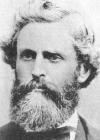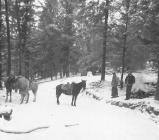1
Ranching at Hat Creek RanchHat Creek Ranch is an interesting example of the establishment and future development of an early ranching operation in the Southern Interior. Due to its location along the Cariboo Wagon Road, its history is more colourful than that of many other ranches in the same area, as the ranch did not have to rely solely on income from cattle and produce sales to survive, but could also tap into the thousands of miners, gold seekers, stagecoach passengers and freight wagon drivers on their way to the goldfields at Barkerville as an additional source of revenue.
2
Historic Hat Creek RanchCirca 1978
Hat Creek Ranch, Cache Creek, British Columbia, Canada
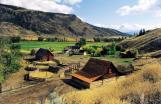 Credits:
Credits:Historic Hat Creek Ranch
3
In 1860, Donald McLean, who had worked for the Hudson Bay Company for 33 years, enlisted Neil McArthur to pre-empt 160 acres at the junction of the Bonaparte River and Hat Creek. It is believed that McLean did not pre-empt the land himself because he had already claimed a farm at Cache Creek, thereby reaching his limit for pre-empting land at that time. During his years with the HBC, Donald had learned that the area offered good winter pasture land and fertile soil. Over the next four years, McLean and his family developed the ranch and the roadhouse. By 1861, he had overcome potential water shortages by constructing the first known flood irrigation system in the colony. Despite innovations of this kind, success could be elusive. With barley and vegetables suffering from lack of rain the following year, McLean opened the irrigation gates only to lose much of the crop to unseasonal frost.After McLean's death in 1864, his family was unable to make a living from the property. With McArthur still the legal owner, they were forced to walk away from their home. George Dunne took possession of the ranch in 1866 and over the next few years purchased and pre-empted land until he controlled several hundred acres. He also added a granary, barn and corrals.
4
Hat Creek RanchCirca 1940 (?)
Hat Creek Ranch, Cache Creek, British Columbia, Canada
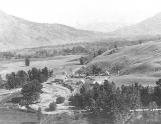 Credits:
Credits:Ashcroft Museum
5
Financial problems forced Dunne to mortgage his holdings in 1873 to Jerome Harper. The Harpers may have been interested in the location of Hat Creek Ranch as a potential resting place for cattle during drives from their Gang Ranch to railheads at Ashcroft and Kamloops. When Jerome died in 1874, his brother Thaddeus inherited the mortgage but Dunne continued to manage the ranch. He was never able to buy back his mortgage and when Thaddeus Harper foreclosed in 1881, due to financial difficulties of his own, all of the holdings were sold to William "Billy" Cargile.7
Billy Cargile drove 250 head of cattle to Hat Creek from his ranch at Dog Creek when he sold it. With the end of the gold rush, ranching was becoming important to the region. Cargile, an experienced rancher, focused on Hat Creek's ranching operations and hired managers for the roadhouse. Despite changing times, there was still a lot of stagecoach and freight wagon traffic on the Cariboo Road, and in 1893 a large barn was built for the BC Express Company's horses.Steve Tingley, owner of the BC Express, purchased Hat Creek Ranch in 1894. Over the years, he added to the BX barn and built a piggery and another large barn. George Hardy leased the ranch in 1904 and the Ashcroft Journal reported: "Mr. Hardy would seem to have made a wise selection in the Hat Creek Ranch when he decided to operate a stock farm. There are over 400 acres of good agricultural land and 3,000 or more acres of pasture land, all fenced. A splendid creek of water runs through that part of the land that can be worked. There is the best of stabling for a large number of horses, and the dwelling house one of the best and largest on the Cariboo road".
Prize winning cattle became the order of the day at Hat Creek when George Carl Grauer took over in 1909. Grauer was one of a succession of managers. In 1910, Charles Gottfried Doering bought the ranch, bringing much needed financial support and stability. He then purchased 950 acres, leases, stock, farming material and produce for $25,500 from the Fergusons, and acquired another 773 acres, eventually owning over 2,000 acres and leasing 18,000. Using her expertise as a horse and cattle breeder, his wife Mary Doering imported Morgan and Kentucky horses. As a "gentleman farmer", Doering left the work to managers such as his son-in-law George Mutter and other staff, while he enjoyed life in the country. He even imported and released 100 Chinese pheasants for his hunting pleasure.
Agriculture was the mainstay of Hat Creek Ranch by the turn of the century. It was a busy place with a never ending amount of work: there were animals to be cared for, gardens and crops to be tended, and all the cooking and housework for the roadhouse to be done. Depending on the season, there could be up to twenty cowboys, a dozen or more potato pickers, a crew of three or four to look after irrigation, a cook, and a couple of housekeepers working at the ranch.
8
Cowboy Life - Branding at Hat Creek RanchCirca 1910
Hat Creek Ranch, Cache Creek, British Columbia, Canada
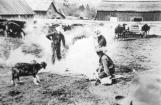 Credits:
Credits:Historic Hat Creek Ranch Photo No. 39
9
Most of the Hat Creek cowboys were First Nations men from the Bonaparte Reserve. Many are listed on payroll documents with names like Shorty, Fatty, and Coyote. Others, like Archie Antoine, Alex and Johnnie Pierro, Tony Basil, Johnny Alexis and Johnny Fountain were from well-known local families. They were paid $2.00 to $3.50 for a long day's work. During the winter, just a few cowboys were needed to look after the ranging livestock, but many more were hired in spring and summer for calving, branding, inoculating, and training horses. The ranch registered brands in 1913: "Z" for horses, and "7L" for cattle.11
Fred Duttweiler took over the management of Hat Creek Ranch in 1914 and focused on improving crop yields. George Doering's stepson John Basil Jackson became manager after World War I and owner in 1930. He and his wife Dorothy, daughter of Henry and Isobella Parke of Upper Hat Creek, built a herd of 1,500 Hereford cattle and continued ranching operations until 1977, when Basil died and Dorothy sold the property. During their years, the land was also used for hay production; potatoes, wheat and oats were an important crop, and at one point, there were over 100 pigs on the ranch.In addition, there was a general store, a lumber mill, and a steady stream of work for the blacksmith. With all this activity, Hat Creek Ranch was a major employer for many years.
